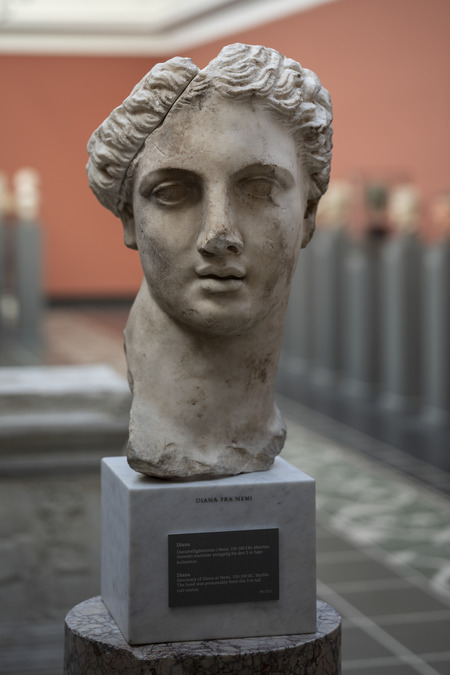Diana from Nemi, Acrolith
Summary
Section of the head from a large acrolith statue believed to be from the Sanctuary of Diana at Nemi.
Description of object
This female head is larger than natural size and sits on a broad, powerful neck. It is turned slightly to the right and at least a little towards the right shoulder. The face is a broad oval with a high triangular forehead. The nose is straight and broad at the root. Large deep-set eyes, set a significant distance apart. The outer corner of each eye is set lower than the inner. A small, slightly open-mouthed with a sweeping Cupid’s bow and teeth shown in the upper jaw. The figure has a double chin and long earlobes. The face is not quite symmetrical, but, on the other hand, this would be optically corrected by the erection of the statue. The hair is parted in the centre and combed in locks towards the top of the head. In front of the left ear a kiss curl is shown and in the whole hairline small hairs are incised. Tool-marks make it probable that the hairstyle could be reconstructed by having some of the hair bound in a bun on the top of the head, while other hair is waved in separate locks down the neck and shoulders.
A large piece of the right shoulder is missing, as is the top of the nose and much of the attached hair segment on the right side. There is minor damage low down on the bust together with scratches on the surface, originally there were more of the additional pieces attached to the head separately, such as a rectangular piece behind the left ear, and the crown of the head. These are missing today. The rear side is, in general, unworked. The upper part of the head was attached with a large rectangular bronze dowel. The face is slightly polished.
The statue was presumably made in the so-called acrolith-technique. This method, which was especially popular in the final two centuries B.C. was used in particular for the production of cult-statues, where only the uncovered parts of the body were executed in marble, while the rest of the statue was made in some other material, bronze, for example, over a skeleton of wood. It is possible that a large drapery-fragment in marble “veneer” in the Castle Museum in Nottingham can be ascribed to the same statue. (N 791, cf. Guldager Bilde, ActaArch 65, 1995 9-10) The drapery fragment is part of a hunting costume with a cloak wrapped around the waist.
The original statue’s height can be reconstructed to c. 3 m
Choice of methods
Visual examination
- Macroscopic
Technical imaging
- UV
- VIL
- IR
Sampling
- Cross section
- Microscopy
- XRF
- FT-IR
- Raman
Bibliography
F. Poulsen, 1951, cat. 81;
LIMC II (1984) Diana no. 108
Motesen, MusTusc 56, 1984-1986 (1986) 291-294, fig. 1-4.
Martin, Tempelkultbilder, 182-191, 236-237, cat. no. 15, fig. 1-4
Guldager Bilde, Acta Arch 65 (1995) 5-11, fig. 4-7
- IN 1517
- Head
- c. 150 - 100 BC
- Roman Republican
- White, fine-grained marble with a golden-brown patina, probably Pentelic.
- Purchased in Rome in 1896 from Count F. Orsini.
- H: 54 cm; from hairline to chin, 30 cm; between outer edge of eyebrows, 14 cm.

